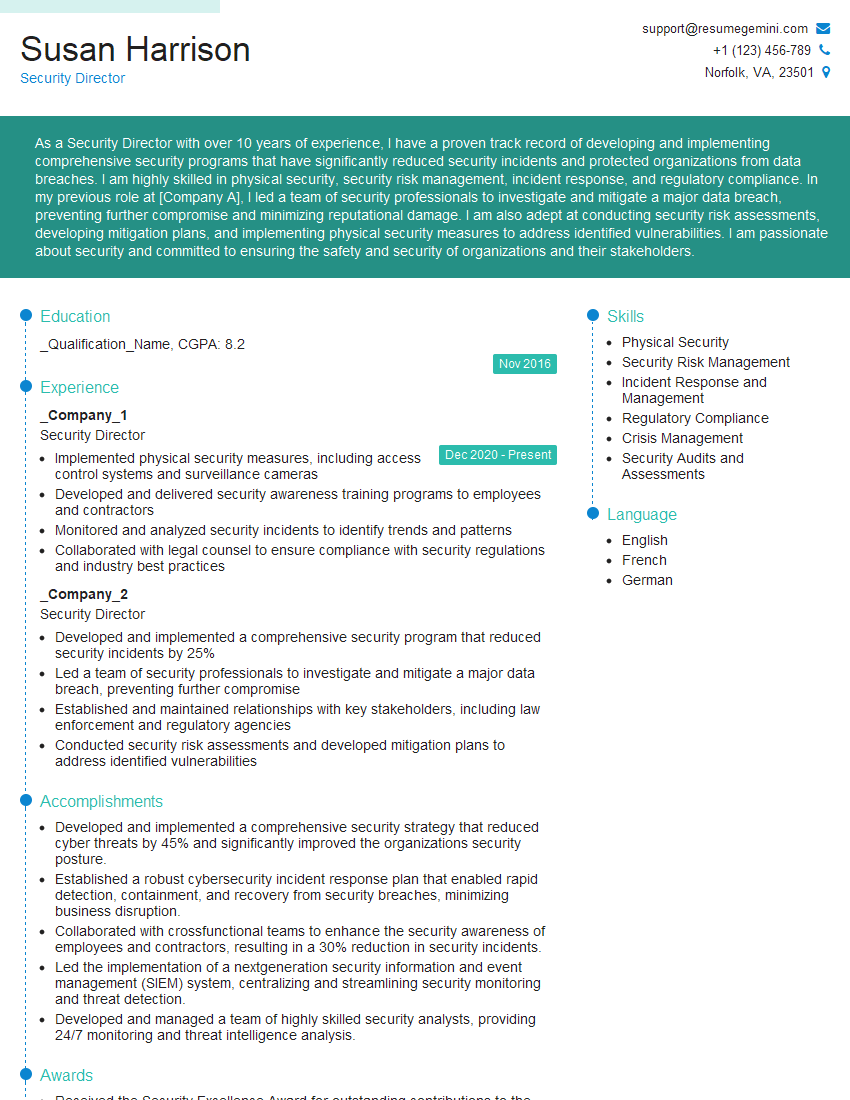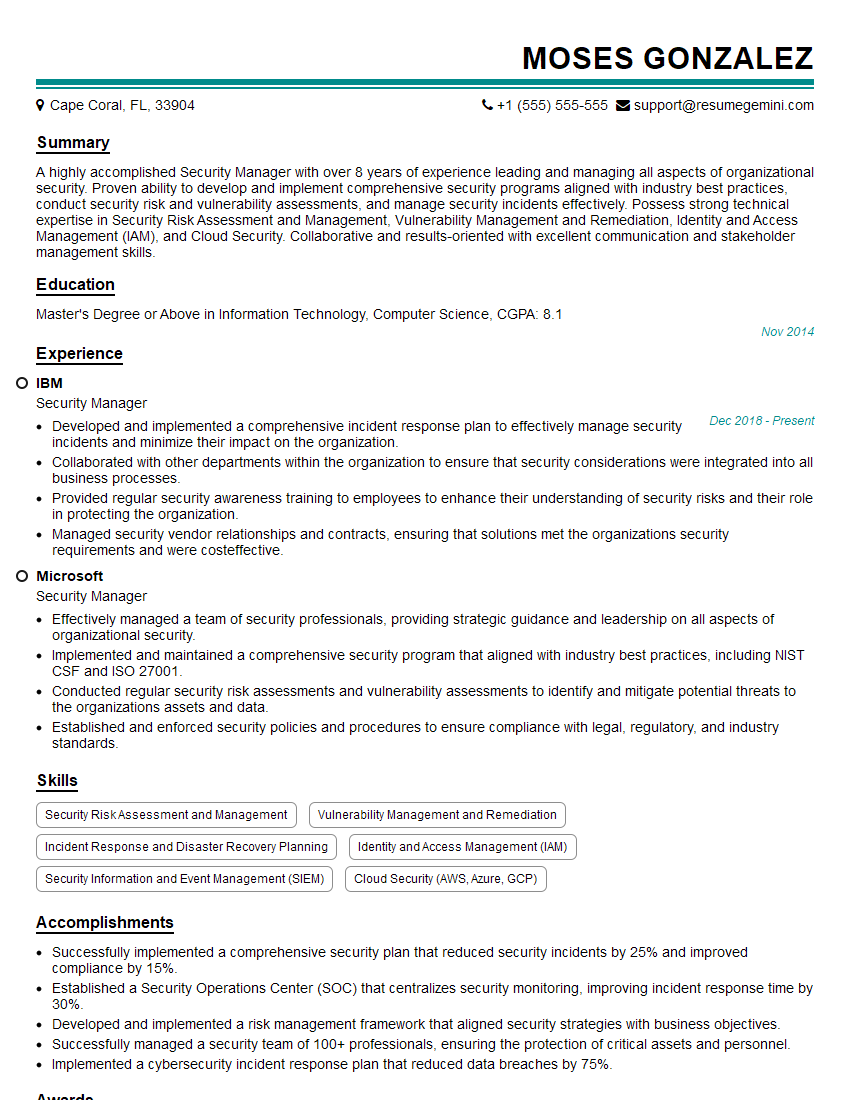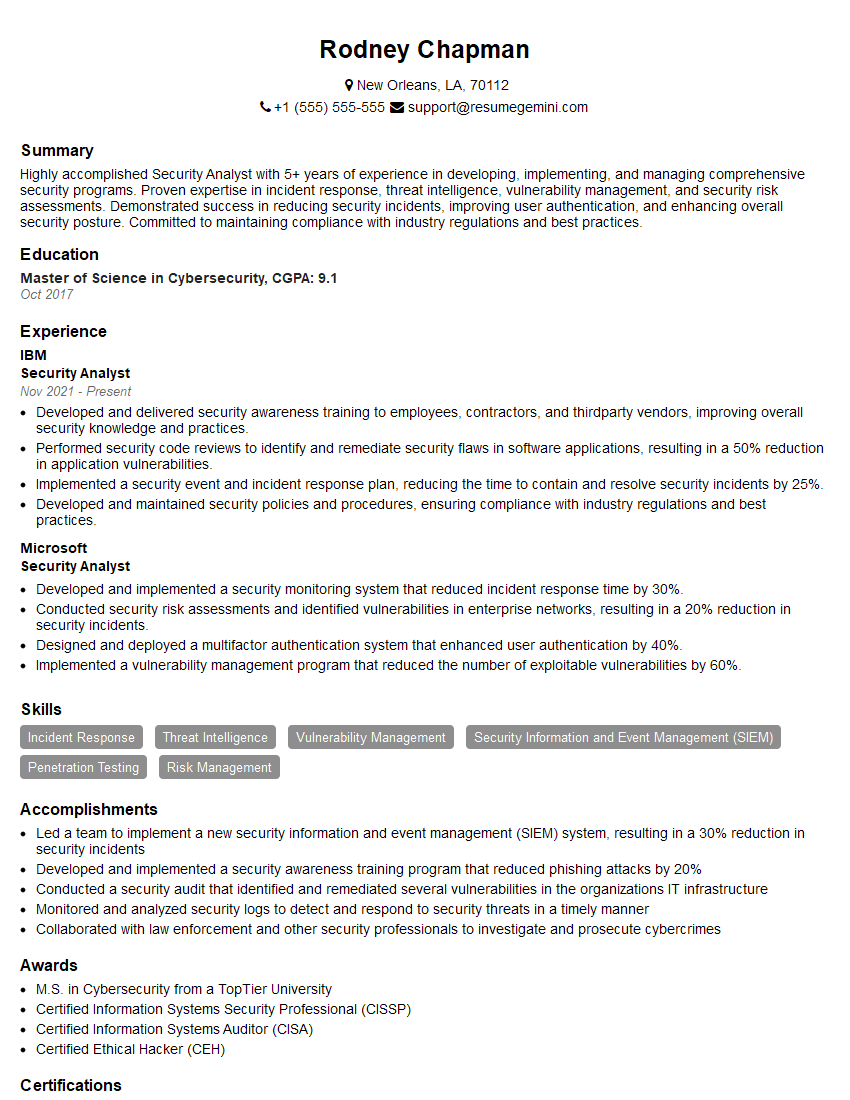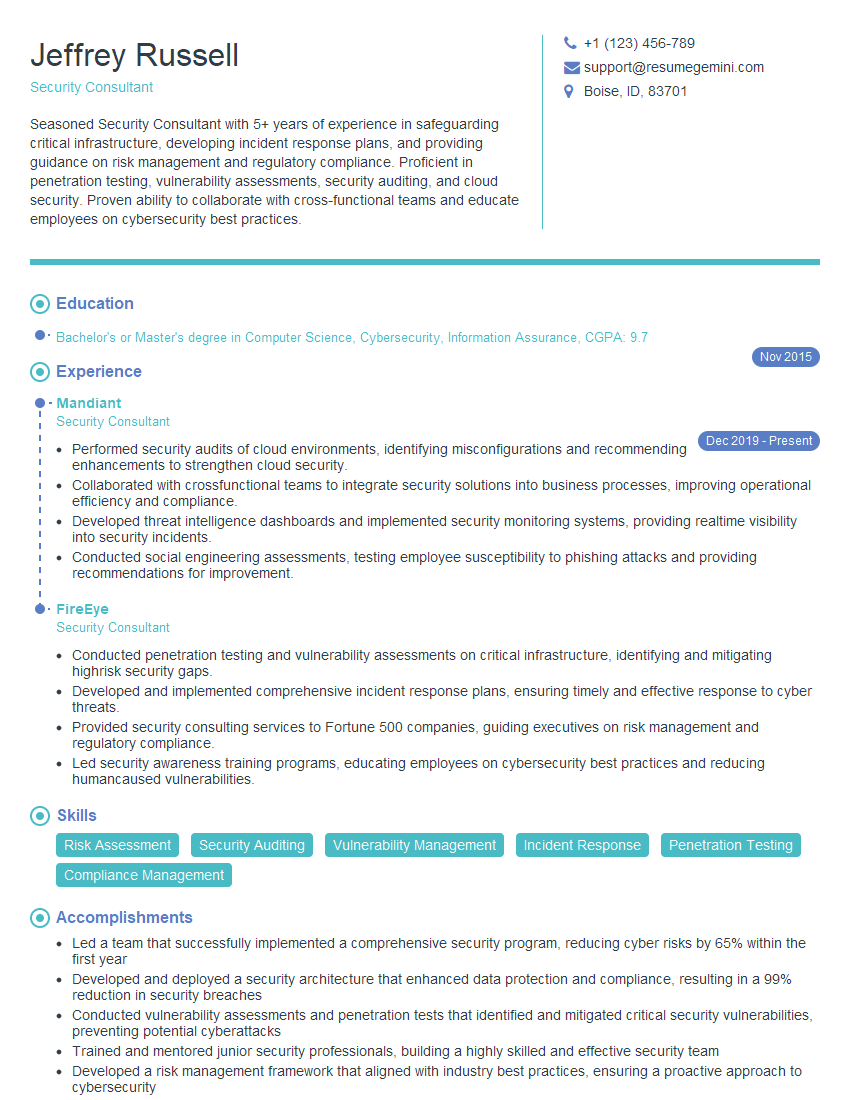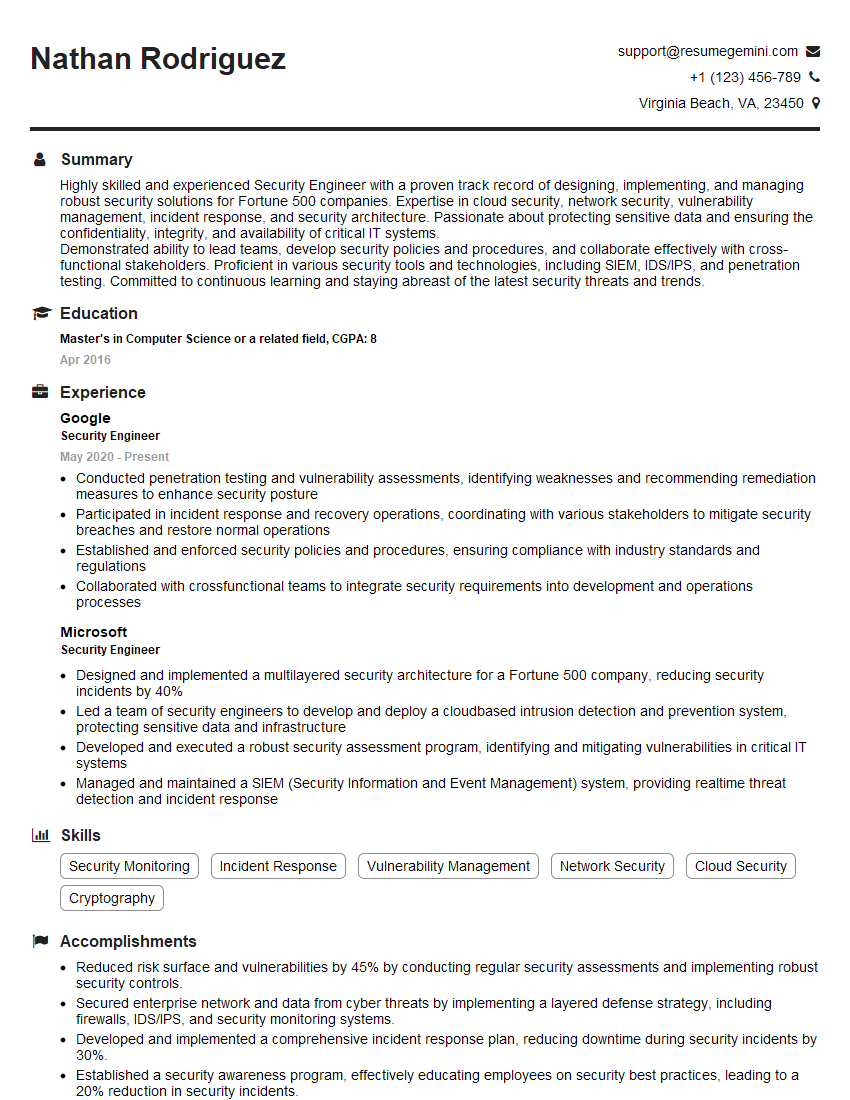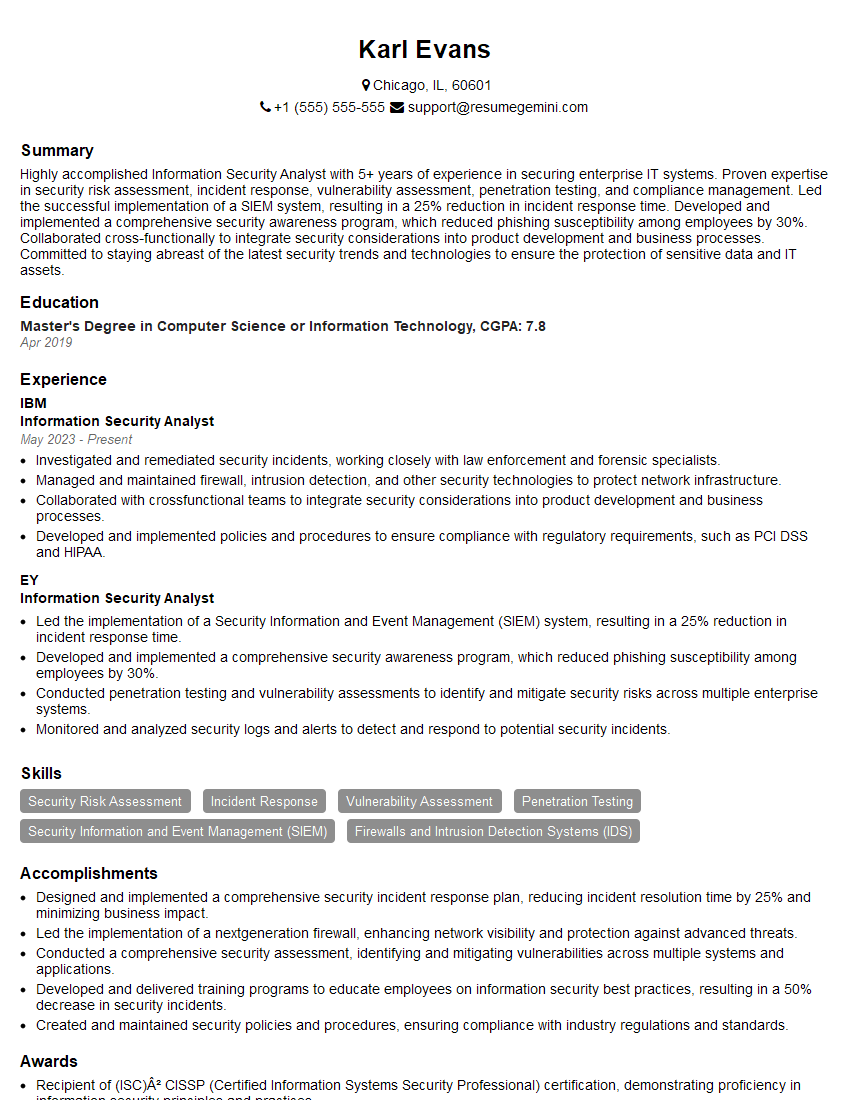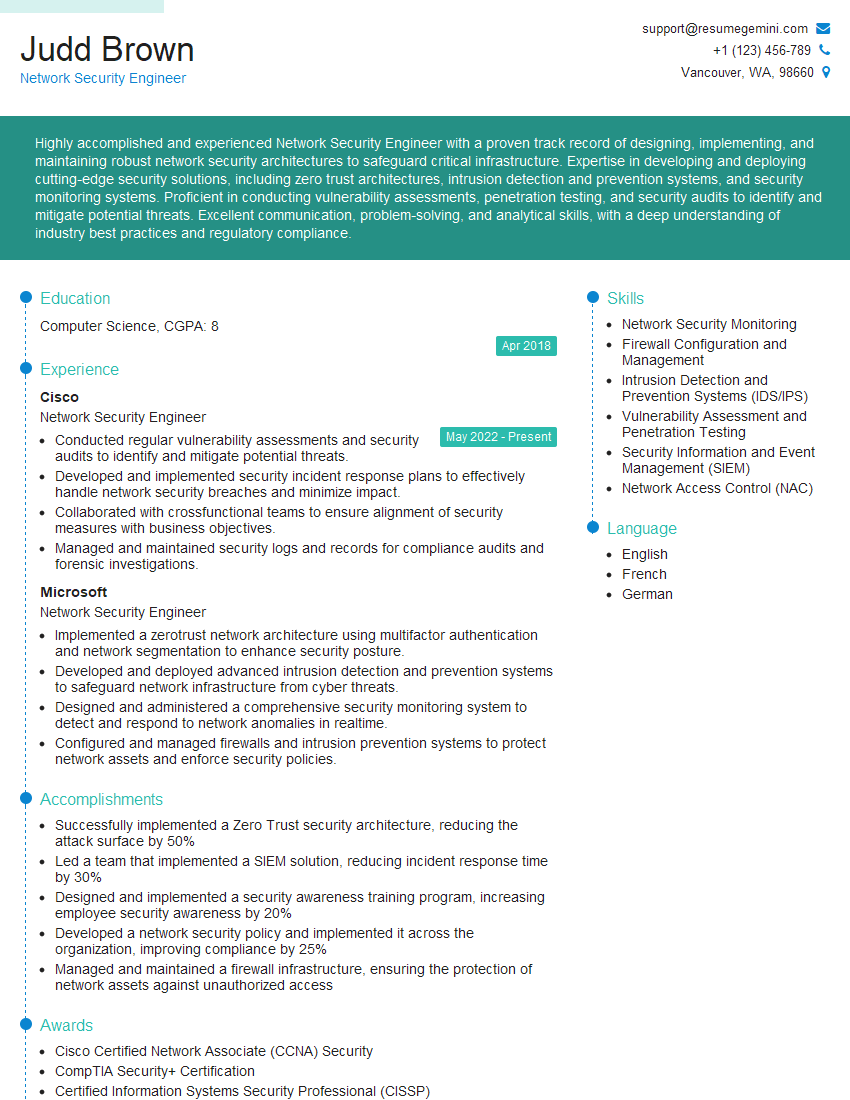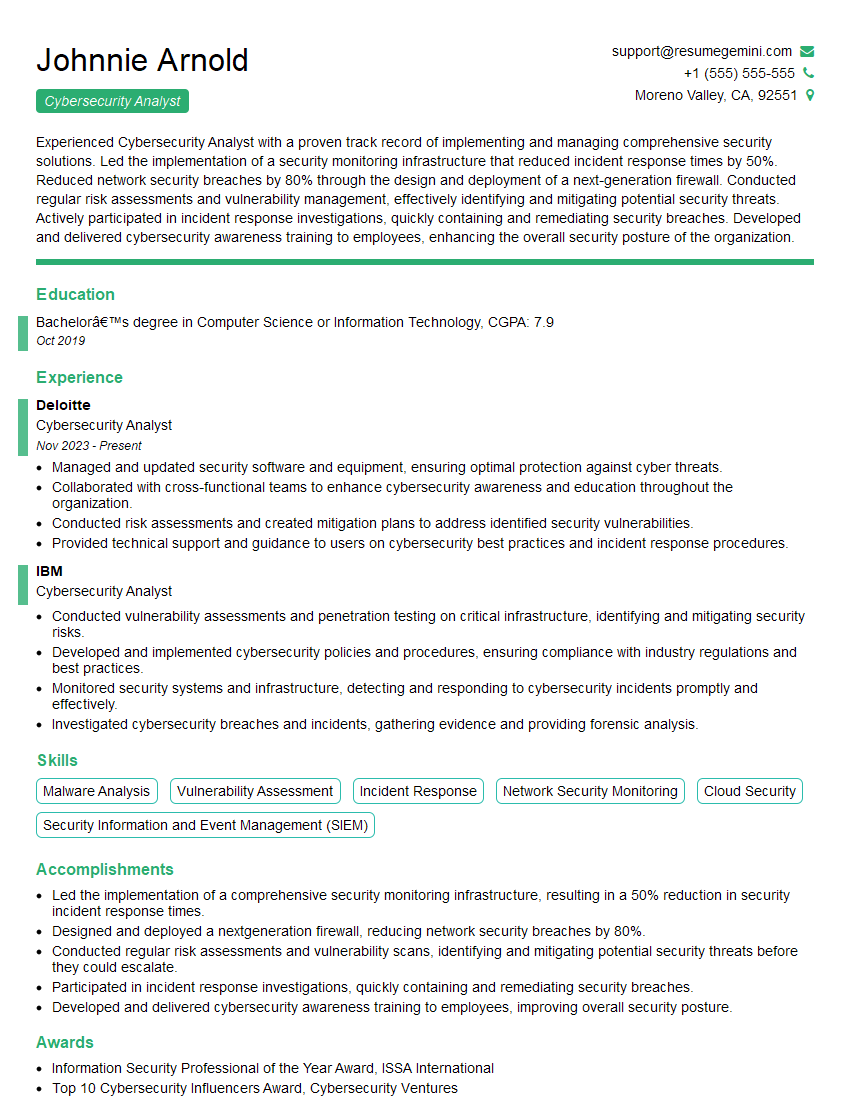Preparation is the key to success in any interview. In this post, we’ll explore crucial Security Monitoring and Detection interview questions and equip you with strategies to craft impactful answers. Whether you’re a beginner or a pro, these tips will elevate your preparation.
Questions Asked in Security Monitoring and Detection Interview
Q 1. Explain the difference between intrusion detection and intrusion prevention systems.
Intrusion Detection Systems (IDS) and Intrusion Prevention Systems (IPS) are both crucial components of a robust security architecture, but they differ significantly in their approach to threats. Think of an IDS as a security camera – it observes network traffic and identifies suspicious activities, alerting you to potential intrusions. An IPS, on the other hand, is like a security guard with the authority to intervene. It not only detects malicious activity but also actively blocks or prevents it from impacting the system.
IDS: Primarily focuses on detecting malicious activity. It analyzes network traffic and system logs for patterns indicative of attacks. Upon detection, it generates alerts, notifying security personnel. IDS are passive; they don’t interfere with the network traffic.
IPS: Takes a more proactive approach. In addition to detection, it actively prevents intrusions by blocking malicious traffic or taking other preventative actions like resetting connections or dropping packets. IPS actively modifies network traffic.
Example: Imagine a denial-of-service (DoS) attack. An IDS would detect the flood of malicious traffic and raise an alert. An IPS would go a step further, blocking the traffic and preventing the DoS from crippling the system. The choice between IDS and IPS often depends on the specific security requirements and the risk tolerance of an organization.
Q 2. Describe your experience with SIEM tools (e.g., Splunk, QRadar, ArcSight).
I have extensive experience with several leading SIEM tools, including Splunk, QRadar, and ArcSight. My work involved designing, implementing, and managing these systems to effectively monitor and analyze security events across diverse environments.
Splunk: I’ve used Splunk extensively for its powerful search capabilities and ability to correlate events from various sources. I leveraged its flexible architecture to ingest logs from diverse systems like firewalls, web servers, and databases, creating dashboards to visualize security trends and anomalies. A particularly challenging project involved optimizing Splunk’s indexing strategy to handle a massive influx of log data from a large-scale application deployment. We were able to reduce query times significantly by implementing more efficient indexing and using appropriate data models.
QRadar: My experience with QRadar focused on leveraging its built-in threat intelligence and security orchestration capabilities. We used QRadar to create custom rules to identify and respond to advanced threats, including malware and insider threats. This involved a significant effort in fine-tuning the rule sets to minimize false positives and ensure high detection accuracy. QRadar also aided in automating incident response through its integration with other security tools.
ArcSight: With ArcSight, I focused on its robust data correlation and reporting capabilities. We used this tool for regulatory compliance, generating reports to demonstrate compliance with various security standards. A key accomplishment involved developing a customized dashboard that presented critical security information in a clear and concise way, significantly improving situational awareness for the security team.
Q 3. How do you prioritize alerts in a high-volume security monitoring environment?
Prioritizing alerts in a high-volume environment is critical for efficient security operations. It’s like sorting through a mountain of emails – you need a system to identify the important ones quickly. My approach involves a multi-layered strategy, combining automated techniques with human expertise.
- Severity-Based Filtering: Prioritize alerts based on predefined severity levels (critical, high, medium, low). Critical alerts, such as compromised systems or data breaches, should be addressed immediately.
- Rule-Based Prioritization: Develop and refine rules within the SIEM to filter out low-priority or common events. This often requires careful tuning to reduce false positives.
- Threat Intelligence Integration: Use threat intelligence platforms to score alerts based on known threats and vulnerabilities. Alerts associated with high-risk threats should be prioritized.
- Machine Learning: Employ machine learning algorithms to identify patterns and anomalies, flagging unusual activity requiring further investigation. This helps detect emerging threats and zero-day exploits.
- Human Validation: Even with sophisticated automation, human review is crucial. Security analysts must triage remaining alerts to ensure accuracy and effective response.
Example: An alert indicating a failed login attempt from an unknown IP address may be low priority unless it occurs repeatedly or originates from a known malicious source. However, an alert about a successful root login on a database server would be high priority and needs immediate attention.
Q 4. What are the common types of security logs you analyze?
Analyzing security logs is the foundation of effective security monitoring. The types of logs I frequently analyze include:
- Firewall Logs: These logs record network traffic, showing allowed and denied connections. Analyzing these logs helps identify unauthorized access attempts and network intrusions.
- Web Server Logs: These logs record website activity, including user access, requests, and errors. They help detect website vulnerabilities and attacks such as SQL injection or cross-site scripting.
- Database Logs: Database logs track user activity, data modifications, and errors. They are essential for detecting data breaches and unauthorized data access.
- Operating System Logs: These logs capture system events, including user logins, file system modifications, and application errors. They provide crucial information about system compromises and malware infections.
- Application Logs: Application-specific logs provide insights into application performance and security. Analyzing these logs helps identify application vulnerabilities and attacks.
- Security Information and Event Management (SIEM) Logs: SIEM systems aggregate and correlate logs from various sources, providing a centralized view of security events. Analyzing SIEM logs allows for comprehensive threat detection and response.
The specific logs analyzed vary depending on the system and the security objectives. Effective log analysis requires a deep understanding of the logging systems and the ability to correlate events from different sources to identify threats.
Q 5. Explain the concept of a kill chain and how it relates to security monitoring.
The kill chain is a model that describes the stages of a cyberattack, from initial reconnaissance to achieving the attacker’s objective. Understanding the kill chain is crucial for effective security monitoring because it allows security professionals to identify attacks at various stages and implement preventative measures.
Stages of the Kill Chain:
- Reconnaissance: The attacker gathers information about the target.
- Weaponization: The attacker creates a malicious payload.
- Delivery: The attacker delivers the payload to the target.
- Exploitation: The attacker exploits a vulnerability in the target system.
- Installation: The attacker installs malware on the target system.
- Command and Control (C2): The attacker establishes a connection to the compromised system.
- Actions on Objectives: The attacker achieves their objective (data exfiltration, system disruption, etc.).
Relevance to Security Monitoring: Security monitoring helps identify activities at various stages of the kill chain. For example, analyzing network traffic may reveal reconnaissance attempts, while monitoring system logs can detect exploitation attempts and malware installation. By detecting attacks at earlier stages, organizations can significantly reduce the impact of successful breaches.
Example: A security monitoring system may detect an unusual amount of network traffic originating from an internal IP address to a known malicious command and control server. This indicates potential data exfiltration (actions on objectives) and allows for timely intervention.
Q 6. Describe your experience with threat intelligence platforms and how you integrate them into your monitoring workflow.
Threat intelligence platforms are essential for proactive security monitoring. They provide crucial information about emerging threats, vulnerabilities, and attack techniques. I integrate threat intelligence into my monitoring workflow in several ways:
- Enriching Security Alerts: I use threat intelligence feeds to enrich security alerts generated by the SIEM. This involves adding context to alerts, such as identifying the attacker, the type of attack, and the potential impact. This contextual information significantly aids in prioritization and response.
- Creating Custom Rules: I leverage threat intelligence to create custom rules within the SIEM to detect specific threats or attack patterns. This allows for more proactive threat detection than relying solely on pre-built rules.
- Identifying Vulnerabilities: I use threat intelligence to identify vulnerabilities in our systems and prioritize remediation efforts. This focuses our patching and security hardening efforts on the most critical vulnerabilities.
- Improving Incident Response: Threat intelligence helps understand the attacker’s motivations and techniques, enabling a more effective incident response. This helps anticipate the attacker’s next steps and contain the attack quickly.
Example: If a threat intelligence feed reveals a new zero-day exploit targeting a specific application, I would immediately create a custom rule in the SIEM to detect this exploit. This would allow for proactive detection and mitigation before the exploit is widely used.
Q 7. How do you identify and respond to a potential zero-day exploit?
Identifying and responding to a zero-day exploit requires a multi-pronged approach focusing on proactive detection, rapid response, and post-incident analysis. Zero-day exploits, by their nature, lack readily available signatures, making traditional signature-based detection ineffective.
Identification:
- Anomaly Detection: Reliance on behavior-based detection systems like intrusion detection systems and SIEM tools using machine learning algorithms to identify unusual patterns in network traffic or system activity.
- Vulnerability Scanning: Regular vulnerability assessments help identify potential zero-day entry points before attackers exploit them.
- Threat Intelligence: Staying abreast of emerging threats through threat intelligence platforms can provide early warnings of potential zero-day attacks.
- Security Information and Event Management (SIEM): Correlating logs from multiple sources within a SIEM can uncover suspicious activity indicative of a zero-day attack.
Response:
- Containment: Isolate affected systems to prevent further spread of the exploit.
- Analysis: Analyze logs and system data to understand the attack and determine its impact.
- Remediation: Apply necessary patches and security fixes to address the vulnerability.
- Recovery: Restore affected systems and data from backups.
- Communication: Communicate with relevant stakeholders about the incident and its impact.
Example: An unusual increase in outbound connections from a server to a previously unknown IP address might indicate a zero-day exploit. This would trigger an investigation involving analyzing system logs and network traffic to identify the source of the malicious activity and implement the response measures described above.
Q 8. What are some common indicators of compromise (IOCs)?
Indicators of Compromise (IOCs) are clues that suggest a system or network has been compromised. They can be anything from a suspicious file hash to unusual network traffic patterns. Think of them as breadcrumbs left behind by an attacker.
- Network IOCs: Unusual connections to known malicious IP addresses or domains, high volume of outbound traffic to unexpected destinations, unusual ports being used.
- Host-based IOCs: Modified system files, unauthorized processes running, creation of unusual accounts, unusual registry entries, presence of malicious code (malware).
- Application IOCs: Unusual application behavior, unexpected login attempts, data exfiltration attempts (large file transfers at unusual times).
- Email IOCs: Phishing emails with malicious links or attachments, emails containing unusual file types or suspicious content, emails sent from compromised accounts.
For example, seeing a large number of connections from a server to a known command-and-control (C2) server in a country you don’t usually do business with, is a strong IOC.
Q 9. How do you perform log correlation and analysis?
Log correlation and analysis is the process of combining data from multiple logs to identify patterns and anomalies indicative of security incidents. It’s like piecing together a puzzle to reveal the whole picture of an attack.
I typically approach this using a Security Information and Event Management (SIEM) system. This involves:
- Data Ingestion: Collecting logs from various sources like firewalls, intrusion detection systems (IDS), servers, and applications.
- Data Normalization: Transforming data from different sources into a consistent format for easier analysis.
- Correlation Rules: Defining rules to identify relationships between events. For example, a failed login attempt followed by a successful login from a different location could suggest a compromised account. These rules are often based on pre-defined signatures or utilize machine learning algorithms.
- Analysis and Alerting: Using the correlated data to identify potential threats and generate alerts. This might involve searching for specific patterns or using anomaly detection techniques.
- Investigation and Response: Investigating alerts to confirm whether they represent genuine threats and taking appropriate actions.
For instance, correlating a failed authentication attempt from an unknown IP address with a subsequent successful login using stolen credentials from the same IP would immediately raise a flag.
Q 10. What are the key components of an effective security monitoring program?
An effective security monitoring program requires a holistic approach. Key components include:
- Clear Objectives and Scope: Defining what you’re trying to achieve (e.g., detecting insider threats, preventing data breaches). Knowing exactly what assets are critical is crucial.
- Data Collection Strategy: Identifying all relevant data sources and implementing effective methods for collecting logs and security data.
- Security Information and Event Management (SIEM): A centralized system for collecting, analyzing, and correlating security data.
- Threat Intelligence: Utilizing threat feeds and intelligence to enhance detection capabilities by providing context to observed events.
- Incident Response Plan: Having a well-defined process for responding to security incidents, including communication protocols and escalation procedures. Tabletop exercises are critical to validating this.
- Monitoring and Review: Continuously monitoring the effectiveness of the program and making adjustments as needed. Regular review of logs and alerts is critical for fine-tuning your detection algorithms.
- Automation: Automating repetitive tasks such as alert triage and incident response to improve efficiency.
Think of it like a security ecosystem, all parts working together to maintain a strong security posture.
Q 11. Explain your understanding of different security monitoring architectures (centralized vs. decentralized).
Security monitoring architectures can be centralized or decentralized, each with its strengths and weaknesses.
- Centralized Architecture: All security data is collected and analyzed in a single location (usually a SIEM). This offers better visibility and simplified management, but can create a single point of failure and introduce latency depending on the scale of data ingestion.
- Decentralized Architecture: Security data is collected and analyzed at multiple locations. This improves resilience and reduces latency but can make it harder to gain a comprehensive overview of security posture and introduce complexities in data correlation across systems.
Many organizations adopt a hybrid approach, combining centralized and decentralized elements to leverage the benefits of both. A centralized SIEM might monitor critical assets, while individual systems handle less critical local monitoring.
The best approach depends on factors like the size of the organization, its geographic distribution, and the sensitivity of the data being protected. A large multinational bank might prefer a hybrid approach, while a small business might find a centralized solution sufficient.
Q 12. How do you handle false positives in security monitoring?
False positives are a significant challenge in security monitoring. They represent alerts that indicate a potential security incident but are actually benign events.
My approach involves a multi-layered strategy:
- Fine-tuning Alert Rules: Reviewing and refining alert rules to reduce the number of false positives. This is often an iterative process, requiring adjustments based on observed alerts.
- Contextual Analysis: Adding more contextual data to alerts (e.g., user location, device type) to improve accuracy.
- Machine Learning: Using machine learning algorithms to identify patterns and reduce false positives. Machine learning models can learn to differentiate between true and false positives over time, but require careful training and monitoring.
- Alert Prioritization: Prioritizing alerts based on their severity and likelihood of being a true positive. This helps focus resources on the most critical threats.
- Automation: Automating the process of investigating and responding to alerts, which can help reduce the burden on security analysts and speed up response times.
For example, if an alert triggers for a high volume of failed login attempts from a single IP, but that IP is known to belong to a legitimate user with connection issues, that would indicate a false positive. This illustrates the value of adding contextual information.
Q 13. Describe your experience with security orchestration, automation, and response (SOAR) tools.
Security Orchestration, Automation, and Response (SOAR) tools are essential for modern security operations. They integrate various security tools, automate repetitive tasks, and streamline incident response. I have experience with several leading SOAR platforms.
My experience involves using SOAR for:
- Incident Response Playbooks: Creating automated playbooks for handling common security incidents, such as malware infections or phishing attacks.
- Threat Hunting: Automating the process of searching for threats within our environment. This uses the SOAR platform’s capabilities to gather and analyze data from various sources in a much more efficient manner than manual techniques.
- Vulnerability Management: Integrating vulnerability scanning tools with SOAR to automate the process of identifying and remediating vulnerabilities.
- Security Information and Event Management (SIEM) Integration: Integrating SOAR with SIEM systems to automate the process of investigating and responding to security alerts. This allows for the automated closure of false positives based on contextual information.
SOAR dramatically improves efficiency and reduces response times. The ability to create automated playbooks to handle common incidents means faster containment of threats and reduces human error.
Q 14. What are your preferred methods for visualizing security data?
Effective visualization of security data is crucial for understanding complex security events and identifying trends. My preferred methods include:
- Dashboards: Using dashboards to provide a high-level overview of key security metrics, such as the number of alerts, the status of security incidents, and the performance of security controls. This provides a quick snapshot of the overall security posture.
- Geographic Maps: Visualizing security events on a geographic map to identify regional trends and patterns. This is particularly useful for identifying attacks originating from specific locations.
- Network Graphs: Visualizing network traffic patterns and connections to identify unusual activity or potential vulnerabilities. This allows us to see how different systems interact and to quickly spot anomalies.
- Time Series Charts: Visualizing security events over time to identify trends and patterns. This is especially useful for spotting long-term changes in network traffic or attack frequency.
- Heatmaps: Visualizing the density of security events across different systems or locations. This helps in identifying areas of high risk.
The key is to choose visualization methods appropriate for the specific data and the audience. A dashboard might be best for executive summaries, while a detailed network graph might be more suitable for security analysts.
Q 15. How do you stay updated on the latest security threats and vulnerabilities?
Staying ahead in security requires a multi-pronged approach. Think of it like being a detective – you need to know the latest criminal methods to effectively solve cases. I leverage several key resources:
- Threat intelligence feeds: I subscribe to reputable threat intelligence platforms like MISP (Malware Information Sharing Platform) and VirusTotal. These provide real-time updates on emerging threats, zero-day exploits, and malware campaigns. It’s like getting a daily briefing on the latest criminal activity.
- Security vulnerability databases: I regularly check the National Vulnerability Database (NVD) and vendor security advisories for newly discovered vulnerabilities in software and hardware. This allows me to prioritize patching and mitigation efforts.
- Industry publications and conferences: I follow leading security blogs, journals (like SANS Institute publications), and attend conferences (like Black Hat and RSA) to stay informed about new attack vectors and best practices. This is like attending professional development workshops to sharpen my skills.
- Security communities and forums: Engaging with online communities like those on Reddit or dedicated security mailing lists provides valuable insights from experienced professionals and helps identify emerging threats early on. This is like networking with fellow detectives to share insights and learn from collective experience.
By combining these methods, I ensure my knowledge base remains current and relevant, allowing me to effectively identify and respond to evolving threats.
Career Expert Tips:
- Ace those interviews! Prepare effectively by reviewing the Top 50 Most Common Interview Questions on ResumeGemini.
- Navigate your job search with confidence! Explore a wide range of Career Tips on ResumeGemini. Learn about common challenges and recommendations to overcome them.
- Craft the perfect resume! Master the Art of Resume Writing with ResumeGemini’s guide. Showcase your unique qualifications and achievements effectively.
- Don’t miss out on holiday savings! Build your dream resume with ResumeGemini’s ATS optimized templates.
Q 16. Explain your experience with different types of security monitoring technologies (network, endpoint, cloud).
My experience spans various security monitoring technologies, each with its own strengths and challenges. Think of them as different lenses through which you can view security events:
- Network Security Monitoring: I’ve extensively worked with network intrusion detection systems (NIDS) like Snort and Suricata, and network traffic analysis tools like Wireshark. I’m proficient in analyzing network flows, identifying suspicious patterns (like port scans or unusual traffic volumes), and correlating events to pinpoint threats. For example, I once used Wireshark to identify a sophisticated phishing attack by analyzing the network traffic related to compromised user accounts.
- Endpoint Security Monitoring: I have experience with endpoint detection and response (EDR) solutions like CrowdStrike and Carbon Black. These tools provide visibility into individual devices, allowing detection of malware, compromised credentials, and other malicious activities. I’m adept at using these tools to investigate endpoint anomalies, such as unusual process execution or registry modifications.
- Cloud Security Monitoring: My experience includes using cloud security posture management (CSPM) tools like Azure Security Center and AWS Security Hub. These tools provide visibility into the security configurations of cloud environments, identifying misconfigurations, vulnerabilities, and potential compliance issues. I’m skilled at analyzing cloud logs, identifying suspicious activity, and integrating cloud security monitoring into existing security information and event management (SIEM) systems. For instance, I’ve used CloudTrail logs to detect unauthorized access attempts to sensitive cloud resources.
Each technology offers a unique perspective, and integrating these various monitoring streams is critical for comprehensive security coverage. It’s like having multiple cameras and sensors to create a complete picture of a crime scene.
Q 17. Describe a time you had to troubleshoot a complex security incident. What was your approach?
During my time at [Previous Company Name], we experienced a ransomware attack targeting our file server. My approach involved a methodical, multi-stage investigation:
- Containment: The first step was to isolate the affected server from the network to prevent further spread. This was like quickly putting out a fire before it spreads to the whole building.
- Eradication: We performed a full system scan for malware and removed all infected files. We used forensic tools to analyze the malware and identify its entry point. This involved thoroughly investigating the logs and system files for any indication of suspicious activities.
- Recovery: We recovered data from backups, ensuring data integrity and business continuity. Regular backups are crucial, akin to maintaining a backup system in case of emergency.
- Analysis: We thoroughly analyzed the attack vectors, determining how the attackers gained access. We investigated whether any vulnerabilities in our systems were exploited and checked user authentication logs for any signs of credential compromise.
- Remediation: Based on the analysis, we patched vulnerabilities, strengthened our network security, enforced stricter access controls, and implemented multi-factor authentication. This ensured that the same attack wouldn’t occur again.
- Documentation: We created a comprehensive incident report detailing the attack, our response, and the remediation steps. This report was instrumental in future security planning and incident response training.
This experience highlighted the importance of a well-defined incident response plan, robust security controls, and regular security awareness training for employees. It also reaffirmed the value of detailed documentation and post-incident analysis.
Q 18. How familiar are you with regulatory compliance frameworks such as SOC 2, ISO 27001, or PCI DSS?
I possess a strong understanding of several regulatory compliance frameworks, including SOC 2, ISO 27001, and PCI DSS. These frameworks provide a structured approach to managing security risks and ensuring compliance with industry standards. Think of them as blueprints for secure operations:
- SOC 2: I’m familiar with the Trust Services Criteria, specifically focusing on security, availability, processing integrity, confidentiality, and privacy. I understand the requirements for designing and implementing effective controls to meet these criteria. This includes establishing robust access controls, data encryption, and incident response procedures.
- ISO 27001: I understand the principles of an Information Security Management System (ISMS) and the requirements for establishing, implementing, maintaining, and continually improving an ISMS. This involves risk assessments, policy development, security controls implementation, and ongoing monitoring and review.
- PCI DSS: I’m well-versed in the Payment Card Industry Data Security Standard, specifically addressing the requirements for protecting cardholder data. I understand the controls needed to secure the cardholder data environment, including network segmentation, access control, encryption, and vulnerability management.
My experience includes assisting organizations with audits and compliance efforts. Understanding these frameworks is essential for building and maintaining a robust and secure infrastructure.
Q 19. What scripting languages are you proficient in for security automation?
I’m proficient in several scripting languages frequently used for security automation, enabling efficient and repeatable tasks:
- Python: Python is my go-to language for tasks like log analysis, vulnerability scanning automation, and creating custom security tools.
# Example: Python script to check for open portsimport socketdef check_port(host, port):try:with socket.socket(socket.AF_INET, socket.SOCK_STREAM) as s:s.settimeout(1)s.connect((host, port))return Trueexcept:return False - Bash/Shell Scripting: I use bash scripting for automating system administration tasks, such as user account management, log rotation, and security patching. This provides powerful command-line capabilities for efficient system administration.
- PowerShell: For Windows environments, I utilize PowerShell for similar automation tasks, leveraging its strengths in managing Active Directory and other Windows-specific components.
Automation significantly reduces the time and effort required for many security tasks, improving efficiency and reducing human error.
Q 20. How do you document security incidents and findings?
Comprehensive documentation is critical for effective incident response and security improvement. I use a structured approach to document security incidents and findings, ensuring clarity, completeness, and traceability. Think of it as creating a detailed case file for each security event:
- Incident Report Template: I typically use a standardized template to capture all relevant information, including the date and time of the incident, affected systems, the nature of the event, the impact, steps taken to contain and remediate, and post-incident analysis.
- Log Analysis and Data Collection: I meticulously analyze logs from various sources (network devices, servers, endpoints, cloud services) to collect evidence and reconstruct the timeline of the incident. This information is crucial for identifying root causes and preventing future occurrences.
- Vulnerability Assessment Documentation: When conducting vulnerability assessments, I document all identified vulnerabilities, their severity, potential impact, and recommended remediation steps. This provides a clear and actionable plan for mitigating risks.
- Version Control and Collaboration Tools: I use version control systems (like Git) and collaborative platforms (like Confluence or Jira) to manage documentation, facilitating team collaboration and ensuring everyone has access to the latest information.
Thorough documentation allows for efficient incident response, informed decision-making, improved security posture, and compliance auditing.
Q 21. Describe your experience with vulnerability scanning and penetration testing.
I have extensive experience in both vulnerability scanning and penetration testing. Think of these as two sides of the same coin – vulnerability scanning identifies potential weaknesses, while penetration testing assesses their exploitability.
- Vulnerability Scanning: I’m proficient in using automated vulnerability scanners like Nessus, OpenVAS, and QualysGuard. These tools help identify known vulnerabilities in systems and applications. I’m adept at interpreting scan results, prioritizing vulnerabilities based on their severity and potential impact, and creating remediation plans.
- Penetration Testing: I have experience conducting both black box (no prior knowledge of the system) and white box (with some system knowledge) penetration tests. This involves systematically attempting to exploit vulnerabilities to assess the overall security posture of a system or network. I use various techniques, including social engineering, network attacks, and application-level attacks. I always obtain explicit permission before conducting penetration testing.
The combination of vulnerability scanning and penetration testing provides a comprehensive assessment of an organization’s security posture, highlighting weaknesses and helping prioritize mitigation efforts.
Q 22. How do you use security metrics to measure the effectiveness of your monitoring program?
Measuring the effectiveness of a security monitoring program relies heavily on key performance indicators (KPIs). These metrics offer quantifiable insights into the program’s success in detecting and responding to threats. I use a multi-faceted approach, focusing on several key areas:
- Mean Time To Detect (MTTD): This metric tracks the average time it takes to identify a security event from its initial occurrence. A lower MTTD indicates a more responsive and effective monitoring system. For example, if MTTD for a specific malware family is consistently high, it signals a gap in our detection capabilities, prompting us to review our rules and possibly add new detection techniques.
- Mean Time To Respond (MTTR): This measures the average time it takes to resolve a security incident after detection. A shorter MTTR indicates efficient incident response processes. We track MTTR across different incident types (e.g., phishing attempts, malware infections) to pinpoint areas needing improvement. A high MTTR for a particular attack vector could point to inefficiencies in our incident response plan.
- False Positive Rate: This metric represents the percentage of alerts generated that are not actual security threats. A high false positive rate leads to alert fatigue and can cause important alerts to be overlooked. Regular tuning of our detection rules and thresholds is crucial to minimize this. For example, if our intrusion detection system (IDS) generates a high number of false positives from a specific network segment, we’d examine that segment’s traffic patterns and refine our rules accordingly.
- Security Event Coverage: This evaluates the percentage of relevant security events successfully detected by the monitoring system. We use this to identify blind spots and areas requiring enhanced monitoring. If coverage for a specific type of attack is low, it suggests a gap in our detection capabilities needing immediate attention.
- Security Incidents per Quarter/Year: A decreasing trend shows improved security posture and indicates our program’s success. Conversely, an increasing trend warrants deeper investigation into the root causes.
By regularly reviewing and analyzing these metrics, we can identify weaknesses, optimize our monitoring processes, and demonstrate the overall effectiveness of our security monitoring program to stakeholders.
Q 23. Explain your experience with different types of security monitoring tools (e.g., NIDS, HIDS, EDR).
My experience spans a wide range of security monitoring tools, each playing a vital role in a layered security defense. I’ve worked extensively with:
- Network Intrusion Detection Systems (NIDS): I’ve used tools like Snort and Suricata to monitor network traffic for malicious activity. NIDS provides a broad overview of network security and is crucial for detecting external threats. For example, I’ve used Snort rules to detect common exploits like SQL injection attempts and cross-site scripting (XSS) attacks.
- Host-based Intrusion Detection Systems (HIDS): Tools like OSSEC and Tripwire allow monitoring of individual systems for suspicious activity. HIDS provides granular insights into the behavior of specific hosts and complements the broader perspective of NIDS. For example, using OSSEC, I’ve detected unauthorized software installations or modifications to system files, providing crucial evidence for incident investigation.
- Endpoint Detection and Response (EDR): I have experience with tools such as CrowdStrike Falcon and Carbon Black. EDR offers advanced threat detection capabilities, providing in-depth insights into endpoint behavior, threat hunting capabilities, and incident response functions. This technology allows for detecting and responding to sophisticated malware and attacks that often bypass traditional security solutions. I’ve used EDR tools to proactively hunt for malicious activity, analyze indicators of compromise (IOCs), and remotely contain infected systems.
In practice, these tools work together. An alert from an NIDS might trigger a deeper investigation using HIDS and EDR on the affected hosts. This layered approach significantly improves our overall security posture.
Q 24. How do you handle escalated security incidents?
Handling escalated security incidents requires a structured and methodical approach. My process follows these steps:
- Initial Assessment: Gather all available information about the incident, including the nature of the threat, affected systems, and potential impact. This step often involves correlating alerts from multiple sources (NIDS, HIDS, EDR, SIEM).
- Containment: Isolate affected systems to prevent further damage or lateral movement of the threat. This might involve disconnecting infected machines from the network or blocking malicious IPs.
- Eradication: Remove the threat from affected systems. This includes deleting malware, restoring backups, and patching vulnerabilities.
- Recovery: Restore systems to full functionality and ensure data integrity. This can involve reinstalling software, recovering data from backups, and conducting thorough system checks.
- Post-Incident Activity: Conduct a thorough post-incident review to identify root causes, lessons learned, and opportunities for improvement in our security posture and response procedures. This phase also includes updating our security monitoring and detection rules to enhance future threat detection and prevention.
- Communication: Throughout the process, maintain clear and concise communication with relevant stakeholders, keeping them informed of the incident’s progress and any potential impact on their operations.
An example of a successful escalation involved a ransomware attack. By quickly isolating the affected systems using our EDR solution, we minimized the damage. Our post-incident review highlighted a vulnerability in our backup system; this led to immediate improvements, making our response to future threats significantly more robust.
Q 25. What is your experience with incident response methodologies?
My experience with incident response methodologies is grounded in established frameworks like NIST Cybersecurity Framework and MITRE ATT&CK. I understand the importance of a structured and repeatable process. I’m proficient in applying the following stages:
- Preparation: Establishing clear roles and responsibilities, developing incident response plans, and regular training and drills.
- Identification: Detecting and classifying security incidents based on their severity and potential impact.
- Containment: Isolating affected systems to prevent further compromise.
- Eradication: Removing the threat and restoring systems to a secure state.
- Recovery: Restoring systems and data to full functionality.
- Post-Incident Activity: Conducting a thorough review to identify root causes, lessons learned, and areas for improvement.
I believe in adapting frameworks to specific organizational needs, tailoring the response based on the nature and severity of the incident. For instance, a minor phishing email would necessitate a quicker, less intense response compared to a sophisticated ransomware attack.
Q 26. How do you contribute to continuous improvement of the security monitoring processes?
Continuous improvement is paramount in security monitoring. I contribute through several key activities:
- Regular Metric Review: As mentioned earlier, tracking and analyzing key metrics like MTTD and MTTR allows for identification of areas requiring improvement. Trends in these metrics can highlight weaknesses in our detection or response capabilities.
- Threat Intelligence Integration: Staying up-to-date with the latest threat intelligence feeds helps us proactively adjust our detection rules and strengthen our defenses against emerging threats. This allows us to anticipate and prepare for newly discovered vulnerabilities and attack techniques.
- Security Information and Event Management (SIEM) Optimization: Fine-tuning our SIEM system is crucial. This involves optimizing alert rules to reduce false positives, improving correlation of security events, and refining our reporting capabilities to gain better insights into our security posture. This iterative process constantly refines our threat detection and response capabilities.
- Automation: Automating repetitive tasks like alert triage and incident response actions enhances efficiency and reduces response times. Automating routine tasks allows our team to focus more time on complex threat hunting and proactive security measures.
- Security Awareness Training: Educating users about security best practices and common threats is crucial for preventing incidents. Regular training reduces the risk of human error, a common entry point for many security breaches.
- Vulnerability Management: Integrating vulnerability scanning and remediation processes into our workflow ensures timely patching of identified vulnerabilities, reducing the attack surface of our environment.
By proactively engaging in these activities, we create a continuous feedback loop that improves our security monitoring effectiveness, reduces risk, and enhances overall security posture.
Q 27. Describe your experience with using machine learning in security monitoring.
Machine learning (ML) is revolutionizing security monitoring by automating threat detection and improving the efficiency of security analysts. My experience involves leveraging ML algorithms for various tasks:
- Anomaly Detection: ML models can identify unusual patterns in network traffic or system behavior that might indicate malicious activity. This is particularly effective in detecting zero-day exploits and novel attack techniques that may not be recognized by traditional signature-based detection systems.
- Threat Hunting: ML can automate the process of searching for malicious activity across large datasets. This significantly reduces the time and resources required for threat hunting, allowing security analysts to focus on more complex tasks.
- Alert Prioritization: ML algorithms can help prioritize security alerts based on their severity and likelihood of being a true positive, minimizing alert fatigue and ensuring that critical alerts are addressed promptly.
- Predictive Modeling: ML models can help predict potential security breaches by analyzing historical data and identifying patterns that may indicate an increased risk. This allows for proactive mitigation strategies.
For example, I’ve implemented an ML model that analyzes network traffic to identify anomalous connections, significantly reducing the time it takes to detect botnet activity. It’s crucial to remember that ML is not a silver bullet; human oversight and expertise remain vital for ensuring accuracy and effectively interpreting results.
Q 28. What are the key differences between preventative and detective security controls?
Preventative and detective security controls are complementary approaches to safeguarding systems and data. They differ primarily in their approach to risk mitigation:
- Preventative Controls: These controls aim to prevent security incidents from occurring in the first place. They act as a barrier, blocking or mitigating threats before they can cause damage. Examples include firewalls, intrusion prevention systems (IPS), access control lists (ACLs), and strong passwords. Think of a preventative control like a locked door – it stops unauthorized access.
- Detective Controls: These controls focus on detecting security incidents after they have occurred. They identify malicious activity, enabling timely response and mitigation. Examples include intrusion detection systems (IDS), security information and event management (SIEM) systems, log monitoring, and security audits. A detective control is like a security camera – it records events after they happen, allowing for investigation and response.
A robust security posture relies on a combination of both. Preventative controls reduce the likelihood of incidents, while detective controls identify and respond to any breaches that do occur. For instance, a firewall (preventative) might block malicious traffic, but an IDS (detective) would log any attempts to bypass the firewall, providing valuable insights for improving security. It’s a layered approach: Prevention is the first line of defense, detection offers a second chance to identify and mitigate threats that bypassed initial defenses.
Key Topics to Learn for Security Monitoring and Detection Interview
- Security Information and Event Management (SIEM): Understanding SIEM architecture, functionalities, and its role in threat detection. Practical application: Designing a SIEM alert rule to detect suspicious login attempts.
- Threat Intelligence: Utilizing threat intelligence feeds and platforms to proactively identify and mitigate potential threats. Practical application: Interpreting threat intelligence reports to prioritize security incidents.
- Log Management and Analysis: Effective log collection, parsing, and analysis techniques for identifying security events. Practical application: Using log analysis tools to investigate a data breach.
- Intrusion Detection and Prevention Systems (IDS/IPS): Knowledge of different IDS/IPS types, deployment strategies, and limitations. Practical application: Troubleshooting false positives in an IDS system.
- Network Security Monitoring: Monitoring network traffic for malicious activity and anomalies. Practical application: Analyzing network flow data to detect lateral movement.
- Endpoint Detection and Response (EDR): Understanding EDR capabilities, and its use in incident response. Practical application: Investigating malware infections using EDR data.
- Security Orchestration, Automation, and Response (SOAR): Understanding how SOAR can automate incident response. Practical application: Designing an automated response workflow for a specific threat.
- Vulnerability Management: Understanding the vulnerability lifecycle and how to prioritize remediation efforts. Practical application: Analyzing vulnerability scan results and recommending mitigation strategies.
- Incident Response Methodology: Familiarity with incident response frameworks (e.g., NIST) and their practical application. Practical application: Developing an incident response plan for a specific organization.
- Cloud Security Monitoring: Understanding cloud-specific security considerations and monitoring tools. Practical application: Configuring cloud security alerts and monitoring.
Next Steps
Mastering Security Monitoring and Detection opens doors to exciting career opportunities with significant growth potential. It’s a highly sought-after skillset in today’s dynamic cybersecurity landscape, offering roles with increasing responsibility and compensation. To maximize your chances of landing your dream job, crafting a compelling and ATS-friendly resume is crucial. ResumeGemini is a trusted resource that can significantly enhance your resume-building experience. Use ResumeGemini to create a professional and impactful resume that highlights your skills and experience effectively. Examples of resumes tailored to Security Monitoring and Detection are available to help guide you.
Explore more articles
Users Rating of Our Blogs
Share Your Experience
We value your feedback! Please rate our content and share your thoughts (optional).
What Readers Say About Our Blog
Hi, I’m Jay, we have a few potential clients that are interested in your services, thought you might be a good fit. I’d love to talk about the details, when do you have time to talk?
Best,
Jay
Founder | CEO
